K-12 Districts Keep Students Safe with Web Filters and Monitors
EdTech Magazine
JUNE 25, 2019
The tools augment lessons in which students are taught to use the internet responsibly. Anything they do on the internet is recorded: the videos that they’re watching, their queries on Google or Bing, the sites they tried to see but couldn’t because they were stopped,” he says. by Chris Hayhurst.














Let's personalize your content